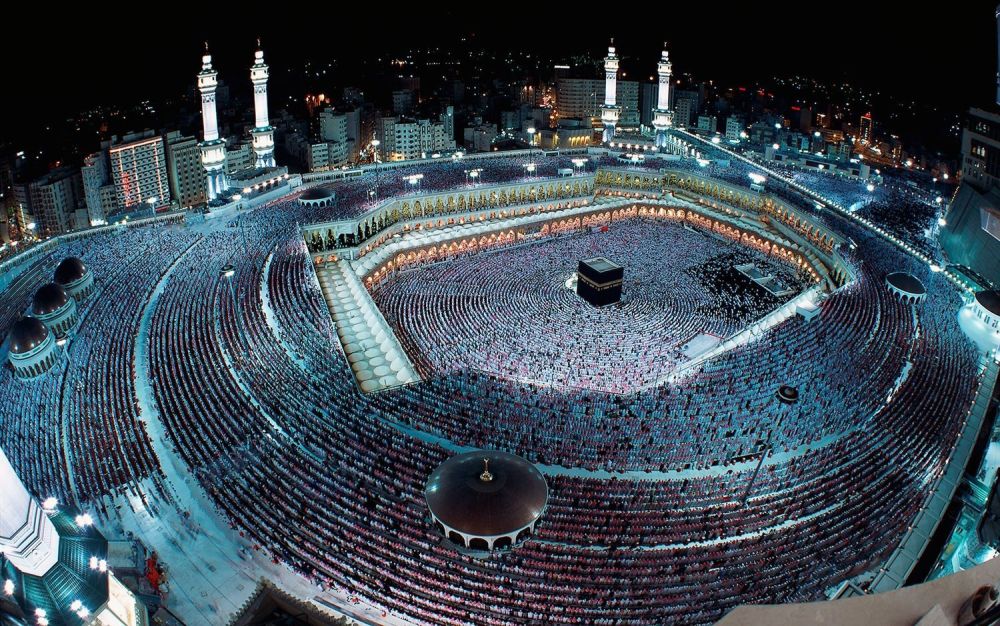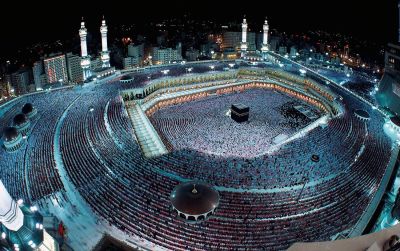

Umrah is a pilgrimage to Mecca that Muslims can undertake at any time of the year, in contrast to the Hajj, which has specific dates according to the Islamic lunar calendar. It includes performing a series of ritual acts symbolic of the lives of Ibrahim (Abraham) and Hagar, and the unity of Muslims. Pilgrims enter a state of sanctity called ihram, where they wear simple white garments and abstain from certain actions. The key rituals include the Tawaf, encircling the Kaaba seven times in a counterclockwise direction, and the Sa'i, walking between the hills of Safa and Marwah seven times. Although shorter than the Hajj, Umrah still requires several hours to complete fully. Pilgrims often find deep spiritual satisfaction in performing Umrah, as it is a demonstration of their faith and devotion.
Tawaf is the act of circling the Kaaba, the cube-shaped building at the heart of Mecca, seven times. Performed by pilgrims during both the Hajj and Umrah, it honors and glorifies Allah. Starting from the Hajar al-Aswad (Black Stone), pilgrims move in a counterclockwise direction, often trying to touch or kiss the Black Stone at the beginning and end of each circuit, although this is not mandatory. Tawaf is a form of worship that shows the unity of believers in the worship of the One God, as they move in harmony around a single central point. Completing the Tawaf can take anywhere from an hour to several hours, depending on the crowd of people.
The Maqam Ibrahim (Station of Abraham) is a small structure that is located near the Kaaba within the Great Mosque of Mecca. It contains a stone believed to bear the imprint of Prophet Abraham's feet. Pilgrims often attempt to pray two rakats behind the Maqam after completing the Tawaf. Muslims believe that Abraham stood on this stone as he was building the Kaaba, and miraculously, the stone softened and his footprints remained. Visiting the Maqam is a way to remember Abraham's faith and dedication. Depending on the crowd, visiting the Maqam Ibrahim can be a brief part of the Umrah or Hajj pilgrimage, but given its significance, people may spend additional time in reflection and prayer.
Zamzam is the holy water from a well located within the Masjid al-Haram in Mecca, and drinking it is considered to be a spiritual and physically rejuvenating act. Muslims believe that the well was miraculously provided by God for Hagar and her son Ishmael when they were in the desert. Drinking Zamzam water is an important part of performing Umrah and Hajj; pilgrims drink from the water to quench their thirst and often take it home in large canisters as a blessed item for themselves and to distribute among family and friends. Since the act of drinking Zamzam is combined with the intention of seeking blessings, the time spent here varies for each individual.
The Great Mosque of Mecca, also known as Al-Haram Mosque, surrounds the Kaaba and is the most sacred place in Islam. It is the focal point for prayers and is considered one of the largest mosques in the world. The mosque's vast open-air and indoor spaces accommodate millions of worshippers throughout the year, especially during Ramadan and Hajj season. Praying here has a special virtue; one prayer at Masjid al-Haram is considered to be equivalent to 100,000 prayers elsewhere. Pilgrims come to perform the five daily prayers, engage in personal supplications, and read the Quran. The mosque also provides an opportunity for attendees to experience unity with Muslims from around the world, reflecting the diversity and brotherhood of the faith.
Friday Prayer, also known as Jumu'ah, is a congregational prayer that Muslims hold every Friday, just after noon, in place of the Zuhr prayer. Participating in Jumu'ah at the Great Mosque of Mecca is an immensely rewarding religious experience. The mosque becomes a site of communal worship and listening to the weekly sermon delivered by a prominent Islamic scholar. It offers a chance to come together with fellow Muslims in a demonstration of faith and solidarity. Although the prayer itself lasts for a short duration, worshippers often arrive early to find space and engage in personal worship before the sermon begins.
Muslims regard the late-night voluntary worship known as Tahajjud as a time of deep contemplation and connection with Allah. In Mecca, the Al-Haram Mosque is open 24 hours a day, allowing for the opportunity to engage in Tahajjud prayer during the quiet hours of the night. The atmosphere within the mosque during these hours is serene and conducive to spiritual reflection. Pilgrims often spend significant time in prayer, supplication, and reading the Quran under the tranquility of the night sky. The length of the Tahajjud prayer varies greatly from person to person, depending on their individual devotion and schedule.
The Sa'i is a ritual walk between the hills of Safa and Marwah, located inside the Great Mosque of Mecca. It commemorates Hagar's desperate search for water for her son Ishmael, and it serves as a symbolic act of piety, patience, and persistence in the face of hardship. Muslims are required to perform the Sa'i seven times, back and forth, starting at Safa and ending at Marwah. This act is performed by pilgrims during the Hajj and Umrah pilgrimages, and while it can be physically strenuous, it is also seen as an opportunity for meditation and prayer. Depending on the crowd and individual pace, the Sa'i usually takes around an hour to complete.
The Kiswa is the embroidered cloth that covers the Kaaba, and it is traditionally replaced annually during Hajj. This happens on the day of Arafah, the second day of Hajj, before Eid al-Adha. The ceremony is a carefully orchestrated event that symbolizes renewal and respect for the sacred site. The new Kiswa, adorned with gold and silver threads on black silk, is prepared many months in advance. Watching this ceremony is a unique experience, reflecting deep respect for Islamic traditions and is a privilege for the pilgrims who are present during Hajj. It is a moment of celebration and reverent observance combining both history and spirituality.
Iftar is the evening meal with which Muslims end their daily Ramadan fast at sunset. Participating in a communal Iftar within the precincts of the Masjid al-Haram offers a unique experience of fellowship and spiritual nourishment. Evidence of generosity and communal harmony is found as pilgrims share food and breaking of the fast typically begins with eating dates followed by water, as per the Prophetic tradition. While there's no set duration for Iftar, as it is preceded and followed by prayers, the experience of eating among a multitude of other fasting individuals is one of unity and gratitude, further accentuating the atmosphere of piety that envelops the city during the holy month of Ramadan.
